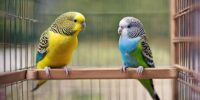How to Distinguish Between a Sun Conure and a Jenday Conure
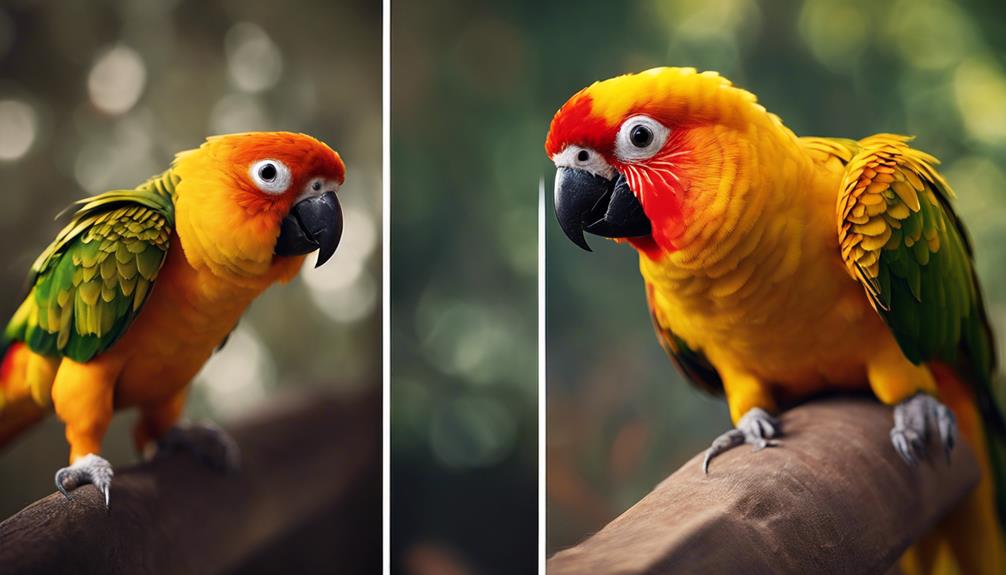
Distinguishing Between Sun Conures and Jenday Conures:
Focus on plumage and size differences to accurately identify each species.
Enhance your understanding of these vibrant conures with a detailed analysis of their unique characteristics.
Key Takeaways
- Sun Conures have more yellow on the head with an orange eye liner, while Jenday Conures feature a yellow head, orange body, and green wings.
- Sun Conures exhibit mottled yellow, blue, and green wings, whereas Jenday Conures predominantly display green wings.
- Size differences can help distinguish between the two species, with Sun Conures growing up to 10-13 inches and Jenday Conures reaching up to 12 inches.
- Understanding the distinct color patterns on the head, body, and wings is crucial in differentiating between Sun and Jenday Conures.
Physical Appearance
How do the physical appearances of Sun Conures and Jenday Conures differ?
Sun Conures are known for their vibrant and striking appearance, characterized by a predominantly yellow head and body with orange eye liner. Their wings display a mottled pattern of yellow, blue, and green hues.
On the other hand, Jenday Conures exhibit a yellow head, orange body, and green wings. The green coloration is more pronounced on their back and wings compared to Sun Conures.
Both Sun and Jenday Conures share similar body sizes and shapes, typically measuring between 10 to 13 inches for Sun Conures and up to 12 inches for Jenday Conures. However, the key distinguishing factor lies in their color patterns and markings on the head, body, and wings. These differences in physical appearance make it relatively easy to tell the two species apart even from a distance.
Coloration and Markings
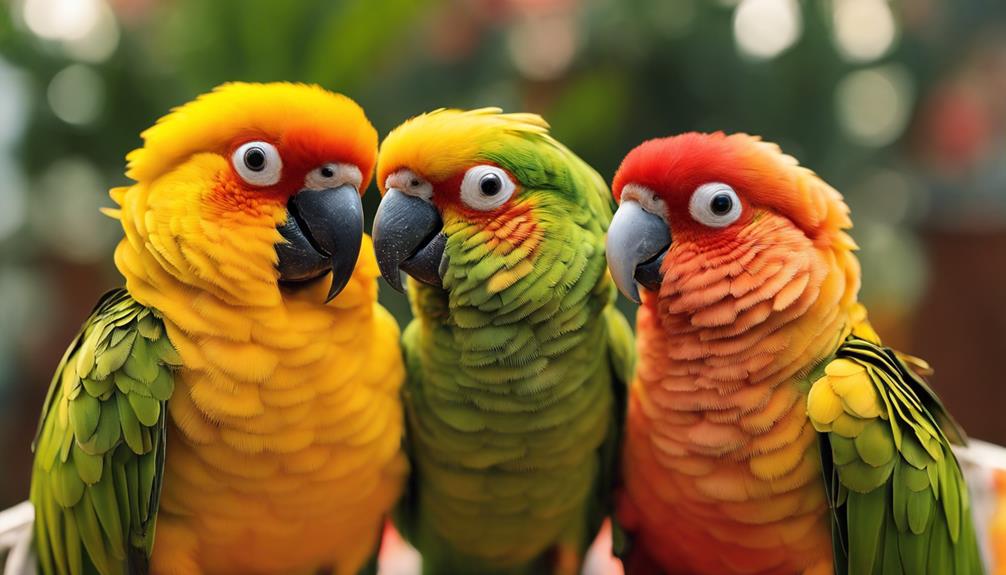
Sun Conures and Jenday Conures can be distinguished by their unique feather colors and facial markings.
The Sun Conure displays a vibrant combination of yellow, blue, green, and orange hues, with distinct salmon-colored patches near the eyes.
In contrast, the Jenday Conure features more predominant green and orange tones in its plumage, creating a different color pattern that sets it apart from the Sun Conure.
Feather Colors
Distinguishing between Sun Conures and Jenday Conures can be achieved through careful observation of their feather colors, which exhibit distinct coloration and markings. Sun Conures display more yellow on their heads and bodies, along with orange eye liner and mottled green wings. In contrast, Jenday Conures have yellow heads, orange bodies, and predominantly green wings.
The wing coloration is a crucial distinguishing factor, with Sun Conures showcasing more yellow, blue, and green hues compared to the predominantly green wings of Jenday Conures. Sun Conures also feature a salmon-colored patch near their eyes, further enhancing their vibrant appearance. On the other hand, Jenday Conures lack this specific coloration around the eye area and have a more uniform green coloration on their backs and wings.
Facial Markings
Facial coloration and markings play a crucial role in differentiating between Sun Conures and Jenday Conures. To distinguish between the two species, one must pay close attention to specific facial features:
- Sun Conures display a salmon-colored patch near their eyes, while Jenday Conures have a yellow head with no distinct eye patches.
- The facial coloration of Sun Conures consists of bright yellow feathers on the head and body, contrasting with the green wings, whereas Jenday Conures exhibit more green on their wings and back.
- Sun Conures exhibit orange eye liner and more yellow on the head, while Jenday Conures have a predominantly green back and wings with a yellow head.
- The distinct facial markings of Sun Conures feature a vibrant mix of yellow, blue, green, and orange, while Jenday Conures showcase predominantly green coloration on their wings and back.
Behavior and Personality Traits
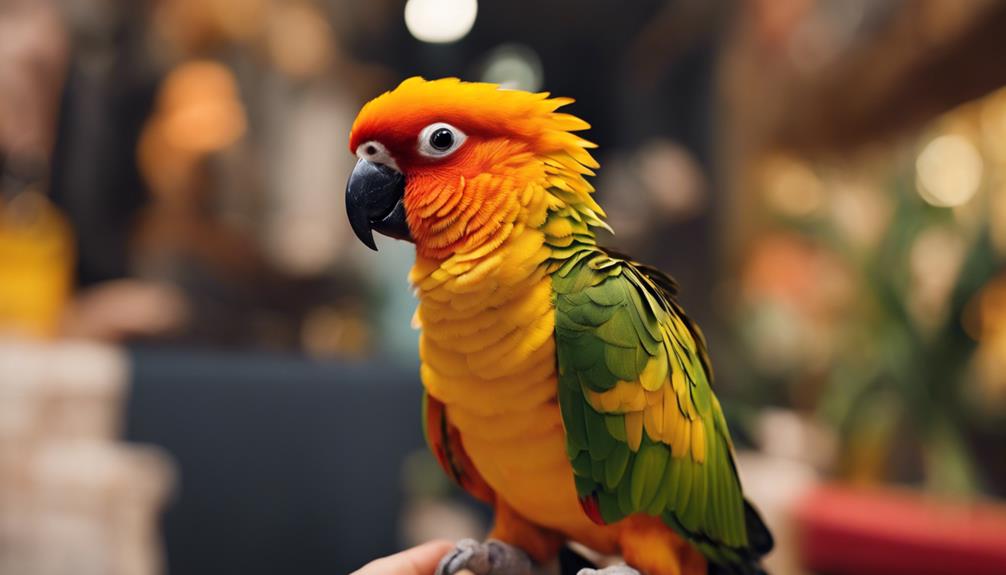
When observing the behavior and personality traits of Sun and Jenday Conures, distinct characteristics become apparent. Sun Conures are often described as clownish and playful, showing a high level of energy and enthusiasm in their interactions. They enjoy engaging in dancing and various interactive play activities, showcasing their vibrant and outgoing nature.
In contrast, Jenday Conures tend to be more reserved and quieter in demeanor, displaying a calmer disposition compared to their Sun Conure counterparts. Both species are intelligent and can be trained to do tricks, which highlights their adaptability and individual personalities.
Understanding these behavioral differences between Sun and Jenday Conures can aid in effectively identifying and interacting with each species, fostering a harmonious relationship. By recognizing these distinct traits, bird enthusiasts can cater to the specific needs and preferences of Sun and Jenday Conures, enriching their interactions and overall well-being.
Vocalization and Sound Differences
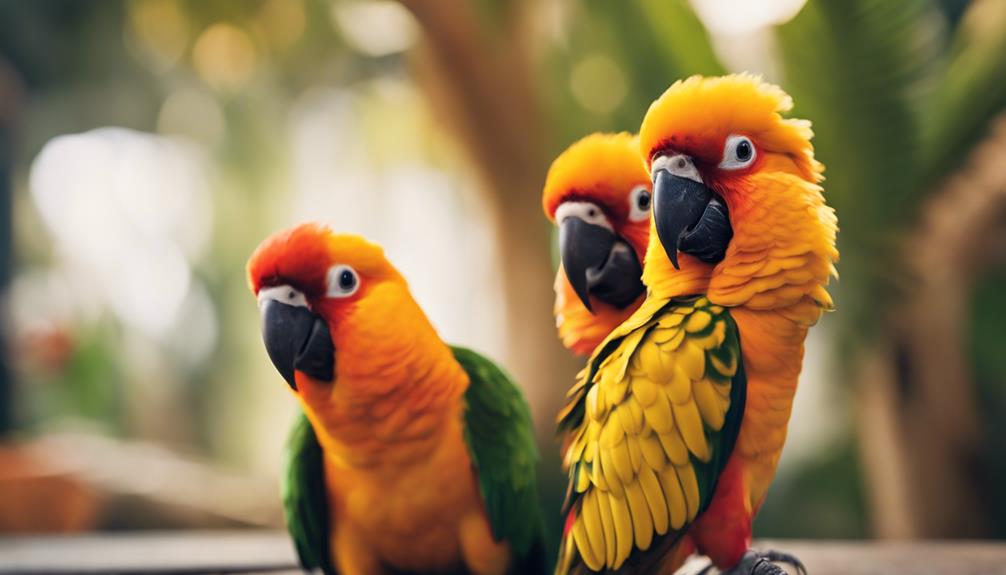
Sun Conures and Jenday Conures exhibit distinct patterns in vocalization, with Sun Conures known for their loud and frequent calls while Jenday Conures tend to emit softer and less frequent sounds.
- Sun Conures are characterized by their loud vocalizations that can be heard throughout the day, often in the form of screeching sounds that carry over long distances.
- Jenday Conures, on the other hand, have a quieter nature when it comes to vocalization, communicating with softer and less frequent sounds compared to Sun Conures.
- The vocal differences between Sun and Jenday Conures play a crucial role in identifying and distinguishing between these two species.
- Understanding the unique sound differences between these conure species can provide valuable insights into their behavior and help bird enthusiasts appreciate the diversity within the conure family.
Habitat and Natural Environment
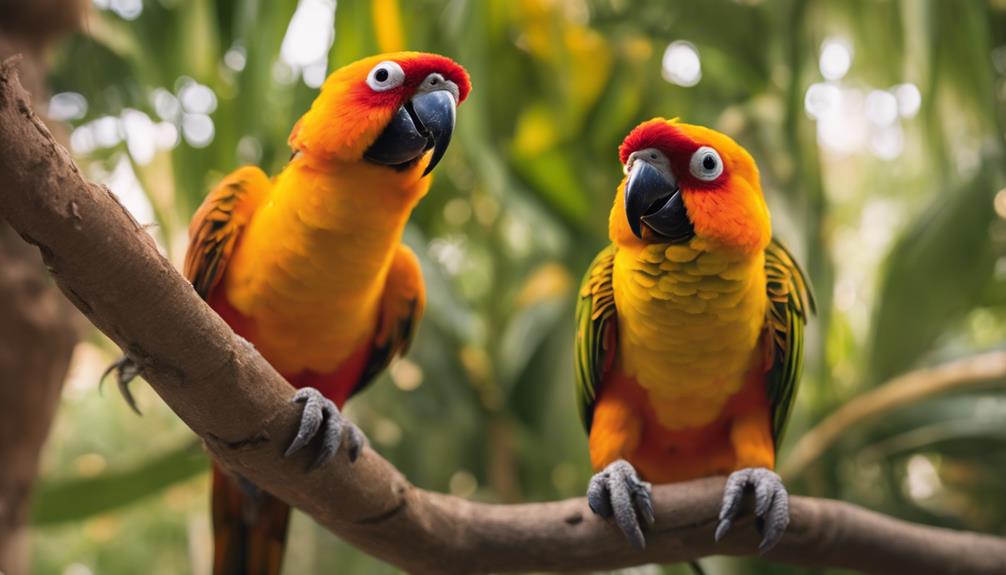
Sun Conures are typically found in tropical forests and wooded habitats, while Jenday Conures prefer savannas and open woodlands.
The distinct habitat preferences of these species influence their behaviors and foraging patterns.
Understanding these natural differences is crucial for ensuring the conservation of both Sun and Jenday Conures.
Sun Conure Habitat
Naturally found in northern Brazil and parts of Guyana, Sun Conures typically inhabit the following environments:
- Savannas: Sun Conures are commonly found in open savannas where they can fly and forage freely.
- Coastal Forests: These birds thrive in the lush vegetation of coastal forests, where they can find shelter and nesting sites.
- Palm Groves: Sun Conures are known to frequent palm groves, feeding on various fruits and nuts found in these areas.
- Tropical Climates: They prefer warm, tropical climates with access to water sources for bathing and drinking, essential for their well-being.
Understanding these specific habitats is crucial for providing suitable captive environments that mirror their natural surroundings accurately.
Jenday Conure Environment
Jenday Conures, native to wooded areas in northeastern Brazil, thrive in diverse environments that encompass forests, savannas, and marshy regions rich with varied food sources. These conures are adapted to tropical climates and are often found in habitats with an abundance of fruiting trees, such as palm groves, where they forage for sustenance.
The presence of water sources like rivers or ponds is crucial for their hydration and bathing needs in the wild. Understanding the vegetation and environmental factors in their native habitat is essential for creating a suitable captive environment for Jenday Conures. Providing a mix of trees, shrubs, and diverse food options can help mimic their natural surroundings and ensure their well-being in captivity.
Natural Differences in Habitats
Quantifying the distinct regional habitats of Sun Conures and Jenday Conures is crucial for understanding their ecological preferences and conservation requirements.
- Sun Conures primarily inhabit northern Brazil and parts of Guyana, while Jenday Conures are native to northeastern Brazil, showcasing their differing regional habitats.
- The natural habitats of Sun and Jenday Conures play a vital role in differentiating between the two species and identifying their specific conservation needs.
- Sun Conures are classified as endangered in the wild, underscoring the significance of preserving their unique habitat requirements.
- In contrast, Jenday Conures aren't facing the same threats, indicating variations in the ecological statuses of their respective habitats.
Habitat preferences are integral in distinguishing between Sun and Jenday Conures, as these environments influence their behaviors and adaptations.
Feeding Habits and Diet Variances
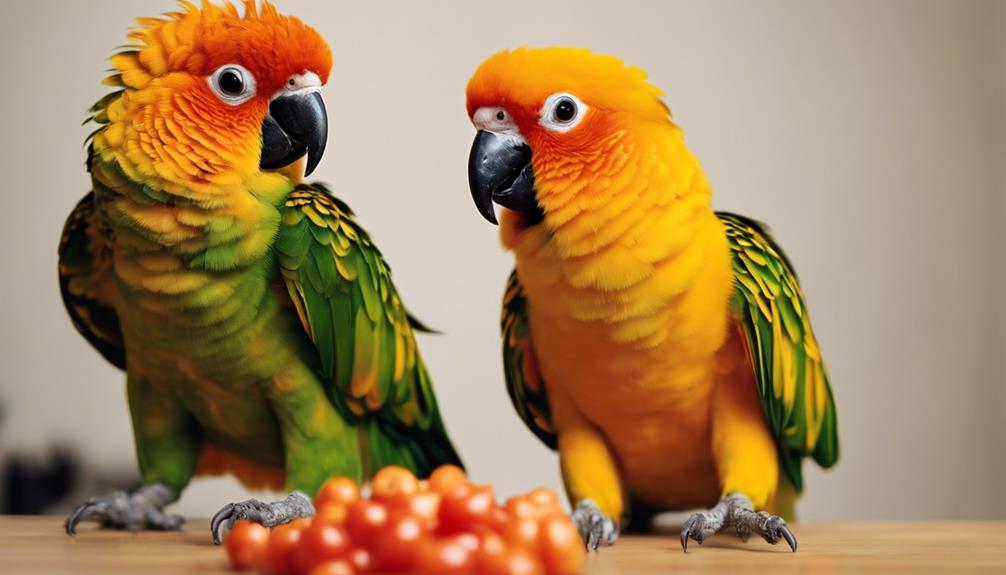
Sun Conures and Jenday Conures exhibit distinct feeding habits and diet preferences that are crucial for their overall health and well-being. Sun Conures tend to enjoy treats like regular Cheerios as part of their diet, while Jenday Conures may have different preferences when it comes to treats and snacks. Both Sun and Jenday Conures have specific dietary needs that should be met for optimal health. Sun Conures may show preferences for certain fruits or vegetables in their diet, and Jenday Conures require a balanced diet to maintain their health and well-being.
| Feeding Habits | Sun Conure | Jenday Conure |
|---|---|---|
| Treats | Cheerios | Varies |
| Dietary Needs | Fruits, Vegetables | Balanced Diet |
Understanding these dietary differences is essential for providing the best care for Sun and Jenday Conures, ensuring their nutritional requirements are met for a healthy and happy life.
Tips for Proper Identification
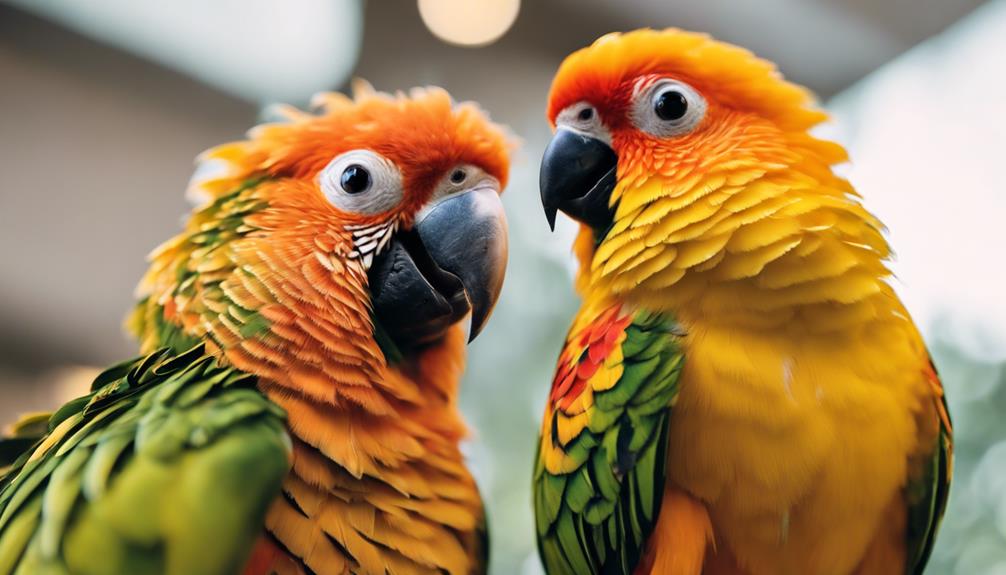
When identifying Sun Conures and Jenday Conures, key physical characteristics such as head coloration, wing patterns, and body size play a crucial role in accurate differentiation. To help in distinguishing between the two species, consider the following tips:
- Head and Body: Sun Conures exhibit more yellow on the head with an orange eye liner, whereas Jenday Conures have a yellow head, orange body, and green wings.
- Yellow Plumage: Sun Conures feature bright yellow plumage on the head and body, with a salmon-colored patch near the eyes, while Jenday Conures display a yellow head, orange body, and green wings.
- Wing Patterns: Sun Conures have green wings mottled with yellow, blue, and green colors, while Jenday Conures predominantly have green wings.
- Size Differences: Sun Conures are larger, growing up to 10-13 inches, whereas Jenday Conures are smaller, reaching a length of up to 12 inches.
Frequently Asked Questions
Are Jendays as Loud as Sun Conures?
In the realm of noise levels, Jenday Conures typically offer a mellower auditory experience compared to the vibrant symphony of Sun Conures. Their vocal behaviors, though distinct, reflect a nuanced spectrum of sound frequency and decibel comparisons.
Can a Jenday and Sun Conure Breed?
Breeding compatibility between Jenday and Sun Conures allows for hybrid offspring due to their genetic differences. Their reproductive behaviors enable successful crossbreeding, resulting in unique color variations and patterns in the offspring.
What Does a Jenday Conure Look Like?
With vibrant feathers resembling a living rainbow, the Jenday Conure captivates onlookers. Its playful antics, diet needs, and habitat requirements make it a delightful companion. Observing this colorful beauty is an enchanting experience.
What Are the Characteristics of the Jenday Conure?
The Jenday conure boasts vibrant colors, displaying a yellow head, orange body, and green wings. These playful birds exhibit friendly temperaments, enjoying social interactions. Their diet preferences include fruits, vegetables, and seeds, aligning with their omnivorous nature.




